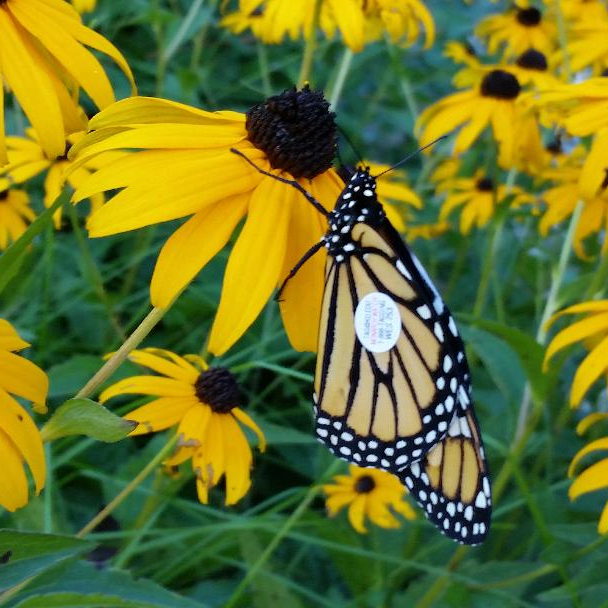By Coggin Heeringa, Interpretive Naturalist, Crossroads at Big Creek, Inc.
A few, but not many, monarch butterflies have been fluttering above the meadows and fields at Crossroads. That may change soon. So Crossroads is collaborating with the Wild Ones of the Door Peninsula to offer our traditional Monarch Tagging Program on Sunday, September 11, at 1:30 pm.
Naturalist Karen Newbern, who is a board member of Wild Ones and a Master Naturalist instructor, will offer a fascinating presentation and will probably bring some butterflies (reared outdoors) to demonstrate tagging techniques. Then participants will be given instructions and nets and set forth to capture and tag these stunning insects.
The monarch butterflies that emerge in late summer are programmed not to mate until next spring. The males are not looking for females; the females are not fluttering around milkweed looking for places on which to lay their eggs.
Instead, they are all looking for nectar-rich flowers on which to feed in preparation for their journey from the Great Lakes region to a remote mountain forest in central Mexico.
Monarch butterflies can migrate with very little effort. Sometimes they just flutter into a weather pattern and are carried on the wind. They can also rise on thermal updrafts – rising warm air – and glide for miles without even flapping their wings.
Even though they have never flown the route to Mexico before, monarch butterflies somehow know to use peninsulas as bridges to shorten their water crossings.
The monarchs which were born during late summer in Ontario and Michigan’s Upper Peninsula tend to funnel onto the Stoningham Peninsula (between Escanaba and the Garden Peninsula) where they gather in huge numbers, roosting at night in the dense arborvitae trees. Trees provide cover as the clouds of butterflies wait … wait for favorable weather which usually follows a cold front.
While on the peninsula, they feed on nectar until the winds out of the north create the thermal updrafts on which they can gain altitude and glide to the Garden Peninsula and then, using islands like steppingstones, onto the Door Peninsula.
It used to be that the monarchs weighed five times more when they arrived in Mexico than they did when they left their breeding areas. However, these days, due to intensive agricultural practices in the Midwest, they are lucky if they have enough stored fats to survive the winter.
While they travel, IF monarchs can find nectar-rich flowers, the lipids stored in their bodies will keep them alive through the winter. In fact, they use so little food during their semi-hibernation that, hopefully, they have energy reserves enough to flutter in their mating dances and to begin the journey north in the spring.
Will Sunday the 11th be the perfect day to find monarchs at Crossroads? Or will we be skunked? Last year, our event was a bit early to catch the migration. Consequently, we had very little luck, so we moved this year’s event into the second week of September.
You like monarchs? Do them a favor. Please wait a few weeks before mowing any wildflowers like goldenrod and asters. Or plant fall-blooming flowers. If you are serious about planting for migrating butterflies (or supplying the final harvest of nectar for honeybees and other pollinators), you will want to attend the Talk and Walk program on Tuesday, September 6 at 6:30 pm.
If you want help in identifying those fall flowers, consider attending the Thursday, September 1 program “Tools of Community Science – How to Use iNaturalist. And to learn to recognize mushroom, on Saturday morning, September 3, Charlotte will be leading one of her popular Wild Mushroom Forays at Crossroads. This is a 1.5 hour walk to search for wild mushrooms along the Crossroads trails will use field identification to determine the family and possibly the genus and species. Edible and poisonous features will be discussed if some of those are seen. Charlotte has been studying wild mushrooms for 50 years and has identified over 600 species in Door County. This program is free, but space is limited and pre-registration is required. To register, go to wildmushroomforay.eventbrite.com.
Crossroads is a 501(c)3 organization committed to offering education, conducting research and restoration, and providing outdoor experiences to inspire environmental stewardship in learners of all ages and from all backgrounds. We welcome your support! Become a member of Crossroads by mailing a contribution to P.O. Box 608, Sturgeon Bay, WI 54235, or donate online at crossroadsatbigcreek.org.



 ALL CONTENT © 2024 BY DOOR GUIDE PUBLISHING
ALL CONTENT © 2024 BY DOOR GUIDE PUBLISHING




